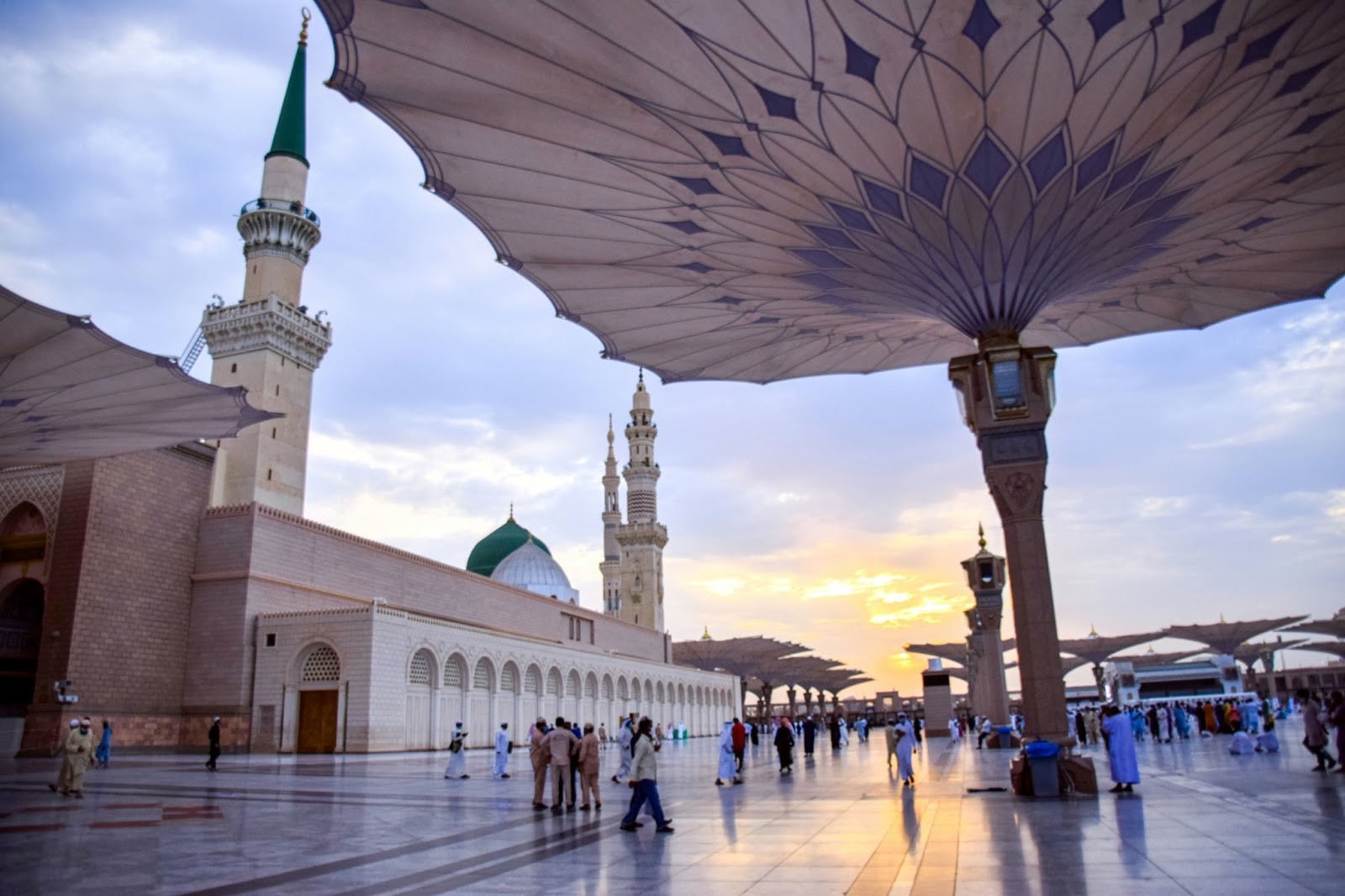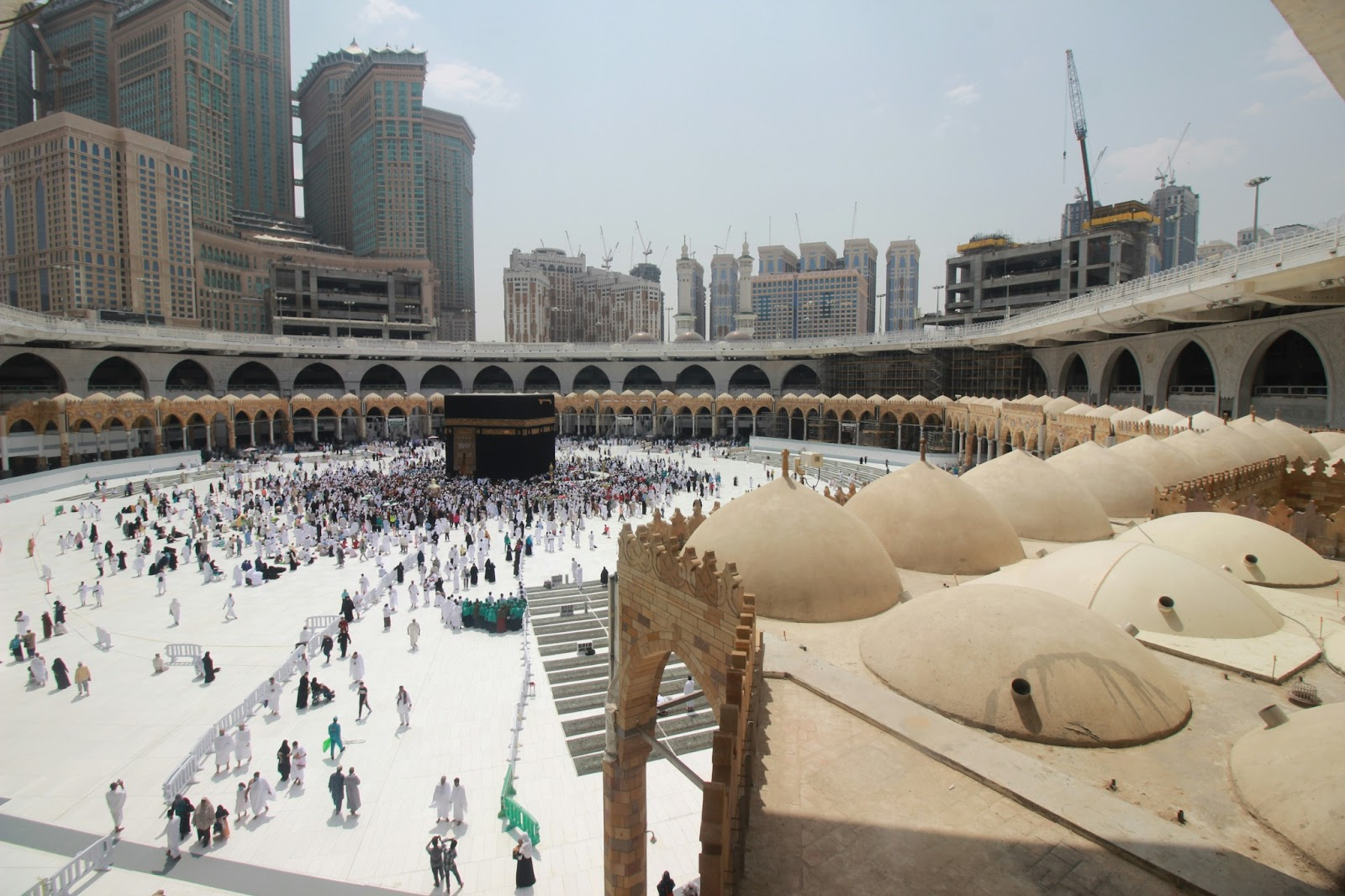For centuries, pilgrims have traced the road between Medina and Mecca with hearts full of devotion. Once it meant days beneath a burning sun, feet sore from desert sands, and the company of caravans swaying patiently across endless horizons. Today, the journey is faster, more comfortable, yet it has lost none of its meaning. However you travel, every mile still carries the weight of history, prayer, and longing.
To journey between the two holiest cities is to step into a living river of faith — one that has never stopped flowing.
Table of Contents
Medina: A City of Peace
Medina is more than a destination; it feels like an embrace. At its heart lies Al-Masjid an-Nabawi, the Prophet’s Mosque. Beneath its great green dome, prayers ripple across the vast courtyard, blending into a single hum of devotion. The marble underfoot stays cool even in the midday heat, while golden umbrellas unfold like giant blossoms, shading those who gather for worship.
Step outside the mosque and Medina’s character reveals itself in layers. The spice markets spill over with the scent of cinnamon and cardamom, dates piled high in baskets glisten like amber, and the call to prayer drifts gently across boulevards lined with modern hotels. Old and new rest side by side here — a reminder that faith never stands still but evolves with each generation.
The Sacred Journey
Where once pilgrims braved weeks of dust and hardship, the sacred journey can now be completed in hours. The train from Medina to Mecca slides smoothly across the desert, a ribbon of steel carrying travellers in air-conditioned comfort. Inside, conversations murmur in dozens of languages, families share snacks, and children press their faces to the windows. Outside, the desert stretches vast and timeless, its ridges painted in ochre and gold, a landscape as unchanging as the devotion it has witnessed for centuries.
Even aboard this modern marvel, the journey retains its reverence. Gazing at the shifting dunes, many find themselves imagining the footsteps of earlier pilgrims, their determination guided only by faith and the stars above. The speed may be new, but the purpose — the longing to reach Mecca — is eternal.
Mecca: The Heartbeat of Faith
Stepping into Mecca fills you with an emotion that overwhelms language. The city thrums with movement and anticipation, as though the streets themselves are alive with the footsteps of pilgrims.
At its centre rises Al-Masjid al-Haram, the Grand Mosque, glowing with brilliance and alive with the energy of millions who gather within its vast courtyards. The Kaaba stands at its heart — simple, powerful, and commanding a reverence that draws every eye and every prayer.
For many, this is the moment their journey becomes complete: standing at the very core of their faith, tears mingling with smiles, a sense of arrival that is at once deeply personal and universally shared.
When Tradition Meets Technology
The Haramain railway that now links Medina and Mecca is part of a broader story in travel — the spread of high-speed trains worldwide. Just as bullet trains in Japan and sleek services in Europe have reshaped how people connect, this network in Saudi Arabia ensures that faith and modern convenience work hand in hand.
For older pilgrims, the train offers rest from arduous travel. For families, it provides reassurance and safety. And for newcomers, it makes what was once daunting feel possible. Here, innovation doesn’t replace devotion; it supports it, carrying more hearts to the places they long to reach.
The Desert’s Eternal Presence
Yet even with these modern comforts, the desert is always there — a presence both humbling and profound. Its vastness can feel unforgiving, its heat demanding respect, yet it holds a purity and stillness that centres the soul.
It is easy to imagine those who once crossed these same sands on foot, their determination etched into every mile. The desert is not simply an obstacle but a companion — austere, eternal, and deeply spiritual.
A Universal Path
Medina and Mecca are singular in their importance to Islam, yet the act of pilgrimage is something humanity shares across cultures. From the Camino de Santiago in Spain to the Kumano Kodo trails in Japan, sacred journeys speak a language of reflection and devotion that resonates far beyond any single tradition.
That is why this route feels so distinctive yet familiar — intensely personal for each traveller, but also part of a wider human longing to walk towards something greater than themselves.
Conclusion: A Path That Endures
From the serenity of Medina to the brilliance of Mecca, this journey binds devotion with distance. It may now take hours instead of weeks, but every traveller steps into a tradition that spans centuries.
The route stays with you long after the journey ends: the hush of prayers rising at dawn, the Kaaba illuminated under the night sky, the stillness of desert horizons at sunset. These moments are carried home in memory, each one a reminder of what it means to belong to a faith, a community, and a history that continues to unfold.
Sacred paths endure not because of the means by which we travel them, but because of the meaning they hold. To walk, to ride, to arrive — it is all part of a story that begins in the heart and never truly ends.


